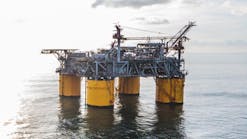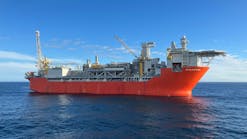Canadian petroleum industry capital and exploration spending will show an 8.8% decline to $10.5 billion (U.S. ) for 1996 after moving up 11.9% to $11.6 billion for 1995.
The significant increase last year was due mainly to increased exploration and production (E&P) spending. Canadian gas production has advanced significantly to support increased exports to U.S. markets. Oil production also has risen.
Concern about prices and future growth of the gas export market will help reduce outlays this year.
E&P spending will post a decline following significant increases in 1994 and 1995. Planned E&P outlays show a drop of 5.8% to $8.7 billion in 1996 on the heels of increases of 12.7% in 1995 and 22.8% in 1994. E&P spending climbed to $8.2 billion in 1994 and $9.2 billion in 1995.
Drilling activity
Baker Hughes Inc.'s count of active rotary rigs in Canada slipped in 1995 to an average 229 for the year from 262 in 1994. However, this was still significantly higher than the 184 active rigs counted in 1993 and only 97 in 1992. Prior to this period, the Canadian rig count had been falling steadily from an average 310 active rigs in 1985.
This year began on a positive note with an average 344 rigs working in January, up from 333 rigs in January last year and 300 in the same month of 1994.
Even so, Oil & Gas Journal predicts a decline in Canadian well completions this year-down 12% to 9,477 wells (OGJ, Jan. 29, p. 76).
A survey by Salomon Bros., New York, also foretold a decline in Canadian E&P spending for 1996. Its survey of 94 companies showed outlays falling 6.4% to $6.602 billion in U.S. dollars (OGJ, Jan. 15, p. 28).
Downstream
Canadian downstream spending also will slide this year, declining 20.8% to $1.84 billion. In 1995, non-E&P spending moved up 8.6% to $2.32 billion.
As in the U.S., there have been large swings in pipeline spending during the past few years, and this has had a major effect on the level of downstream spending.
Spending for crude oil and petroleum product pipelines will plummet to only $26 million from $144 million 1995. Spending was $208 million in 1994.
Outlays for natural gas pipelines will fall to $337 million from $946 million in 1995. Spending in this category was $815 million in 1994.
The number of miles of natural gas pipeline to be laid in Canada in 1995 is 485 (OGJ, Feb. 5, p. 27). This is down sharply from 1,638 miles planned for 1995. Crude and product pipeline mileage planned fell to 67 miles in 1996 from 372 miles planned for 1995.
Spending on all other types of petroleum transportation will move up 3.6% to $58 million from $56 million in 1995 and $48 million in 1994.
Canadian refining and marketing outlays will increase. Refining will be up 57.7% at $503 million after an increase of 9.6% last year to $319 million.
Marketing outlays will be up 3.1% at $332 million compared with an increase of 17.1% in 1995 to $322 million.
Petrochemical spending will rise sharply, increasing 75.6% in 1996 to $144 million. Spending last year was $82 million, down 12.8% from 1994.
Spending on mining and other energy, which includes oilsands development, will rise 12.9% in 1996 to $323 million. Outlays in this category were up 10.9% in 1995 at $286 million.
Capital spending on other activities fall to $116 million from $167 million in 1995. Last year's outlays for other activities moved up 12.8% from $148 million in 1994.
Company plans
Among companies that disclosed budget plans to the press, Petro Canada will boost 1996 capital spending on property, plant, and equipment and exploration to $870 million from $853 million spent in 1995.
Upstream operations in western Canada will account for about $300 million of the planned spending, with $240 million directed toward conventional E&P and strategic property acquisitions. Spending on field projects off eastern Canada, including Hibernia and Terra Nova, will total about $210 million. About $30 million will be spent in Algeria to complete development of an oil discovery and for further exploration on the Tinrhert block.
Downstream spending will be almost $290 million, with $60 million enhance environmental performance. About $180 million will go for refining and marketing, and more than $100 million will be earmarked for lubricants, mainly to complete a plant expansion.
Suncor plans to spend about $475 million in 1996, up almost 20% from 1995. The increased outlays will expand conventional E&P and oilsands development.
Suncor will allocate $260 million to oilsands, $160 million to the conventional oil and gas division, and $55 million to refining and marketing.
The oilsands group's capital program includes projects to expand production, plan a new mine site, reduce sulfur dioxide emissions, and make other environmental and sustaining capital investments.
The resources division will invest to increase reserves and production through exploration, development, and acquisitions. Suncor also plans to spend about $17 million on a project to test new technology at its Burnt Lake heavy oil property.
Downstream investments will improve environmental, energy, and operating efficiency.
Paragon Petroleum set a 1996 capital budget of $15 million, down from $20.4 million spent in 1995. The company expects to drill 17-25 wells in 1996 after drilling 29 in 1995.
Copyright 1996 Oil & Gas Journal. All Rights Reserved.


